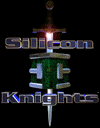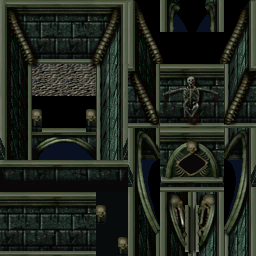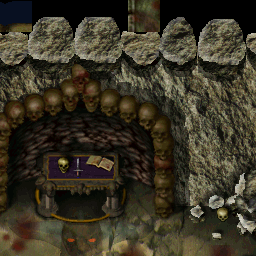How Did They Do That?
Some of the technical stuff used in making Blood Omen: Legacy of Kain.
Many of you have asked: What programs/computers were used to create Legacy of Kain?

People have commented on the wonderful use we've made of our big expensive (SGI) computers, when in fact we have none. All the art and development you see in Legacy of Kain was created with 486, and later Pentium 90 computers. Above all, it's not high powered tools, but high powered talent that makes the difference.
Our original intention was to make the cinematics and flight sequences in "broadcast quality" video resolution. We did some calculations and found that with the computing power available to us, rendering time for such an endeavor would have taken more time than we had available. On top of that, the Sony PlayStation, and PCs for that matter, were unable to display smooth video at that resolution.
The Cinematics
The cinematics were created using a combination of several programs. 3D Studio (v4) was used for most backgrounds, and Animation Master (Playmation) was used to construct and animate the characters. Afterwards these two elements were combined together with the use of Animator Studio. This is also where some of the SFX were created.
The Flight Sequences
We were pleasantly surprised to find an inexpensive tool, Vista Pro, was able to do the flights over a fractally generated landscape with the high-realism look that we were looking for. Seamlessly integrating Nosgothian cities and mountainous castles was a painstaking task for our artists. The buildings were all constructed using 3D Studio (v4).
A large amount of hard drive space was required for the raw flight sequence and cinematic images, each one typically requiring 2000 frames at 230 k per frame (over 400 meg per cinematic!). Copying them over our office network was quite resource-intensive (slow). A "Personal Animation Recorder" (PAR) was used to playback the sequence of video frames at the desired frame rate, so we could preview our work. (The video frames are later processed into a Sony PlayStation-specific video format which can be played back at 15 frames per second on the PlayStation.)
Tile Graphics


There were two basic types of tile graphics in the game, one being the fully tileable sets which were used to construct generic buildings, passageways, caves, etc. These tile sets were created by our artists using Photoshop and Animator Pro. Much work goes into making tiles that have interchangeable positions relative to each other, to give a seamless and varied look to the environment.
For a more grand look, some tile sets were created to be placed down in one pattern only. These sets were made a number of ways, some done with 3D Studio, others with Photoshop, depending on the desired look. This type of tile set would be used for specific story elements, such as Nupraptor's Skull Fortress, or the Willendorf Castle.
Characters, Creatures, and Monsters, oh my...
Smooth, believable, character animation is an art form, and using such tools as Animation Master (a.k.a.: Playmation), Photoshop, and Animator Pro, our artists were able to model and animate over 170 creatures.
Sound Effects
Sounds Effects were mixed (edited/massaged) using our only Mac, using a program called Digi-Design.
Game and Cinematic Music
The music was created by an excellent composer, Steve Henifin, whose musical vision for Legacy of Kain matched ours perfectly. (see the themes sheet)
Programming
Game code was written entirely in C, using the Sony PlayStation-specific PsyQ compiler, and tested on SonyPS development stations. Internal Tools (programs) were written in C, using the Watcom compiler.
Game Assembly
Our designers assembled the game using our (internally developed) Mapmaker program which let them place and arrange all game elements, including the tiles, characters, objects, powerups, lighting, etc.